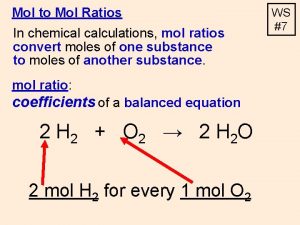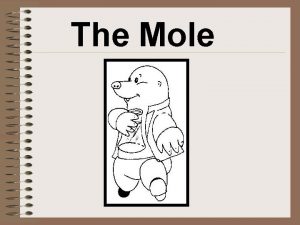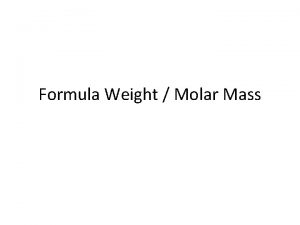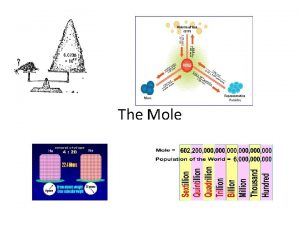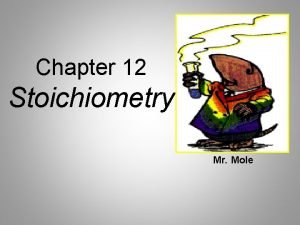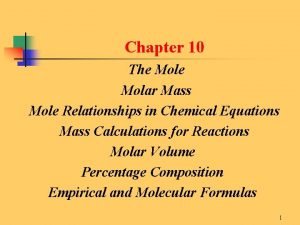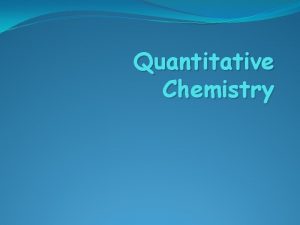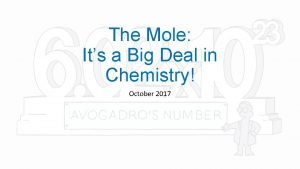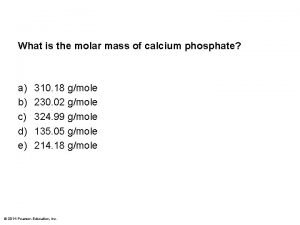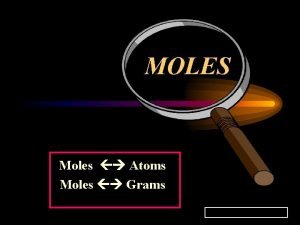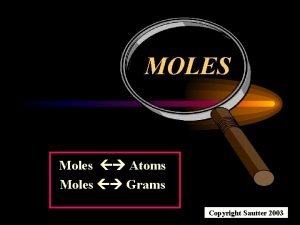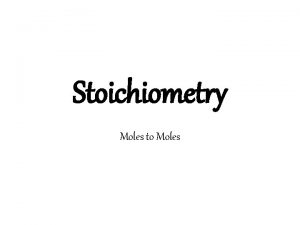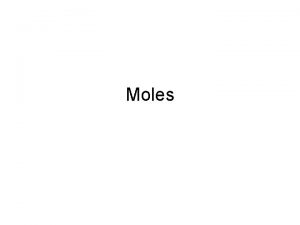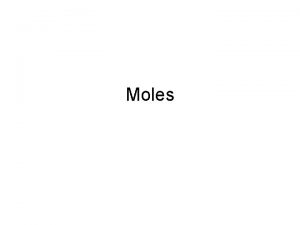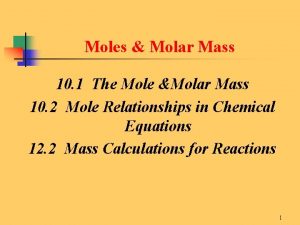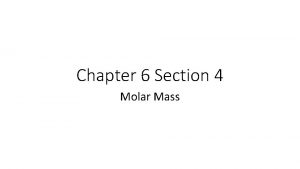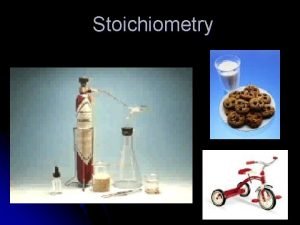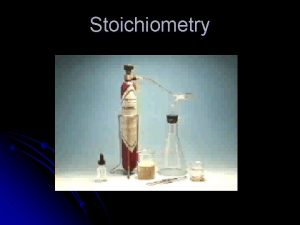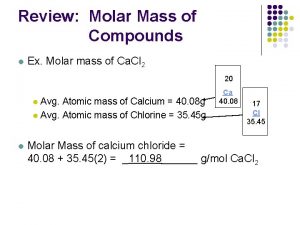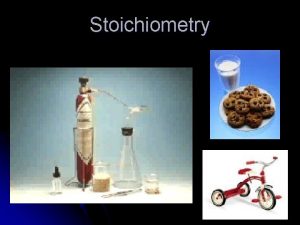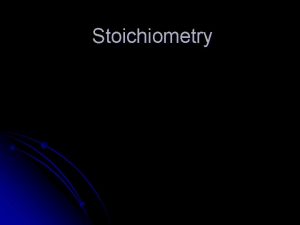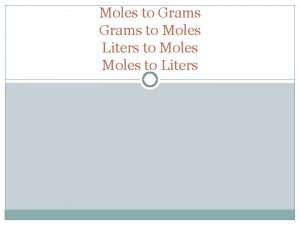Section 3 Moles of Compounds The molar mass












![MASS-TO-MOLE CONVERSION FOR COMPOUNDS Use with Example Problem 8. Problem Calcium hydroxide [Ca(OH)2] is MASS-TO-MOLE CONVERSION FOR COMPOUNDS Use with Example Problem 8. Problem Calcium hydroxide [Ca(OH)2] is](https://slidetodoc.com/presentation_image_h/be2577ef4feaa1cc0d0e100551a6c5c6/image-13.jpg)






- Slides: 19

Section 3: Moles of Compounds The molar mass of a compound can be calculated from its chemical formula and can be used to convert from mass to moles of that compound. K What I Know W What I Want to Find Out L What I Learned

• 8(A) Define and use the concept of a mole. • 8(B) Use the mole concept to calculate the number of atoms, ions, or molecules in a sample of material. • 2(G) Express and manipulate chemical quantities using scientific conventions and mathematical procedures, including dimensional analysis, scientific notation, and significant figures. Copyright © Mc. Graw-Hill Education How Atoms Differ

Essential Questions • What are the mole relationships shown by a chemical formula? • How is the molar mass of a compound calculated? • How can the number of moles be converted to the mass of a compound and vice versa? Copyright © Mc. Graw-Hill Education Moles of Compounds

Vocabulary Review • representative particle Copyright © Mc. Graw-Hill Education Moles of Compounds

Chemical Formulas and the Mole Chemical formulas indicate the numbers and types of atoms contained in one unit of the compound. One mole of CCl 2 F 2 contains one mole of C atoms, two moles of Cl atoms, and two moles of F atoms. Copyright © Mc. Graw-Hill Education Moles of Compounds

MOLE RELATIONSHIPS FROM A CHEMICAL FORMULA Use with Example Problem 6. Problem Aluminum oxide (Al 2 O 3), often called alumina, is the principal raw material for the production of aluminum (Al). Alumina occurs in the minerals corundum and bauxite. Determine the moles of aluminum ions (Al 3+) in 1. 25 mol of Al 2 O 3. KNOWN UNKNOWN Number of moles = 1. 25 mol Al 2 O 3 Number of moles = ? mol Al 3+ ions Response ANALYZE THE PROBLEM You are given the number of moles of Al 2 O 3 and must determine the number of moles of Al 3+ ions. Use a conversion factor based on the chemical formula that relates moles of Al 3+ ions to moles of Al 2 O 3. Every mole of Al 2 O 3 contains 2 mol of Al 3+ ions. Thus, the answer should be two times the number of moles of Al 2 O 3. Copyright © Mc. Graw-Hill Education Moles of Compounds

MOLE RELATIONSHIPS FROM A CHEMICAL FORMULA Copyright © Mc. Graw-Hill Education EVALUATE THE ANSWER Because the conversion factor is a ratio of whole numbers, the number of significant digits is based on the moles of Al 2 O 3. Therefore, the answer is expressed correctly with three significant figures. As predicted, the answer is twice the number of moles of Al 2 O 3. Moles of Compounds

The Molar Mass of Compounds The molar mass of a compound equals the molar mass of each element, multiplied by the moles of that element in the chemical formula, added together. The molar mass of a compound demonstrates the law of conservation of mass. Copyright © Mc. Graw-Hill Education Moles of Compounds

Converting Moles of a Compound to Mass For elements, the conversion factor is the molar mass of the compound. The procedure is the same for compounds, except that you must first calculate the molar mass of the compound. Copyright © Mc. Graw-Hill Education Moles of Compounds

MOLE-TO-MASS CONVERSION FOR COMPOUNDS Use with Example Problem 7. Problem The characteristic odor of garlic is due to allyl sulfide [(C 3 H 5)2 S]. What is the mass of 2. 50 mol of (C 3 H 5)2 S? Response ANALYZE THE PROBLEM You are given 2. 50 mol of (C 3 H 5)2 S and must convert the moles to mass using the molar mass as a conversion factor. The molar mass is the sum of the molar masses of all the elements in (C 3 H 5)2 S. KNOWN UNKNOWN number of moles = 2. 50 mol (C 3 H 5)2 S molar mass = ? g/mol (C 3 H 5)2 S mass = ? g (C 3 H 5)2 S Copyright © Mc. Graw-Hill Education Moles of Compounds

MOLE-TO-MASS CONVERSION FOR COMPOUNDS Copyright © Mc. Graw-Hill Education Moles of Compounds

Converting the Mass of a Compound to Moles The conversion factor is the inverse of the molar mass of the compound. Copyright © Mc. Graw-Hill Education Moles of Compounds
![MASSTOMOLE CONVERSION FOR COMPOUNDS Use with Example Problem 8 Problem Calcium hydroxide CaOH2 is MASS-TO-MOLE CONVERSION FOR COMPOUNDS Use with Example Problem 8. Problem Calcium hydroxide [Ca(OH)2] is](https://slidetodoc.com/presentation_image_h/be2577ef4feaa1cc0d0e100551a6c5c6/image-13.jpg)
MASS-TO-MOLE CONVERSION FOR COMPOUNDS Use with Example Problem 8. Problem Calcium hydroxide [Ca(OH)2] is used to remove sulfur dioxide from the exhaust gases emitted by power plants and for softening water by the elimination of Ca 2+ and Mg 2+ ions. Calculate the number of moles of calcium hydroxide in 325 g of the compound. Response ANALYZE THE PROBLEM You are given 325 g of Ca(OH)2 and must solve for the number of moles of Ca(OH)2. You must first calculate the molar mass of Ca(OH)2. KNOWN UNKNOWN mass = 325 g Ca(OH)2 Molar mass = ? g/mol Ca(OH)2 Number of moles = ? mol Ca(OH)2 Copyright © Mc. Graw-Hill Education Moles of Compounds

MASS-TO-MOLE CONVERSION FOR COMPOUNDS EVALUATE THE ANSWER To check the reasonableness of the answer, round the molar mass of Ca(OH)2 to 75 g/mol and the given mass of Ca(OH)2 to 300 g. Seventy-five is contained in 300 four times. Thus, the answer is reasonable. The unit, moles, is correct, and there are three significant figures. Copyright © Mc. Graw-Hill Education Moles of Compounds

Converting the Mass of a Compound to Number of Particles Convert mass to moles of compound with the inverse of molar mass. Convert moles to particles with Avogadro’s number. This figure summarizes the conversions between mass, moles, and particles. Copyright © Mc. Graw-Hill Education Moles of Compounds

CONVERSION FROM MASS TO MOLES TO PARTICLES Use with Example Problem 9. Problem Aluminum chloride (Al. Cl 3) is used in refining petroleum and manufacturing rubber and lubricants. A sample of aluminum chloride has a mass of 35. 6 g. a. How many aluminum ions are present? b. How many chloride ions are present? c. What is the mass, in grams, of one formula unit of aluminum chloride? Response ANALYZE THE PROBLEM You are given 35. 6 g of Al. Cl 3 and must calculate the number of Al 3+ ions, the number of Cl− ions, and the mass in grams of one formula unit of Al. Cl 3. Molar mass, Avogadro’s number, and ratios from the chemical formula are the necessary conversion factors. The ratio of Al 3+ ions to Cl− ions in the chemical formula is 1: 3. Therefore, the calculated numbers of ions should be in that same ratio. The mass of one formula unit in grams will be an extremely small number. KNOWN UNKNOWN mass = 35. 6 g Al. Cl 3 number of ions = ? Al 3+ ions number of ions = ? Cl− ions mass = ? g/formula unit Al. Cl 3 Copyright © Mc. Graw-Hill Education Moles of Compounds

CONVERSION FROM MASS TO MOLES TO PARTICLES Copyright © Mc. Graw-Hill Education Moles of Compounds

CONVERSION FROM MASS TO MOLES TO PARTICLES EVALUATE THE ANSWER A minimum of three significant figures is used in each value in the calculations. Therefore, the answers have the correct number of digits. The number of Cl− ions is three times the number of Al 3+ ions, as predicted. The mass of a formula unit of Al. Cl 3 can be checked by calculating it in a different way. Divide the sample mass of Al. Cl 3 (35. 6 g) by the number of formula units contained in the mass (1. 61 × 1023 formula units) to obtain the mass of one formula unit. The two answers are the same. Copyright © Mc. Graw-Hill Education Moles of Compounds

Review Essential Questions • What are the mole relationships shown by a chemical formula? • How is the molar mass of a compound calculated? • How can the number of moles be converted to the mass of a compound and vice versa? Copyright © Mc. Graw-Hill Education Moles of Compounds
 How to calculate grams to moles
How to calculate grams to moles Mole in chemistry formula
Mole in chemistry formula How to convert grams to mole
How to convert grams to mole Molar mass of compounds
Molar mass of compounds Molar solution
Molar solution How to convert moles to grams
How to convert moles to grams Mass/molar mass
Mass/molar mass Read pp
Read pp Formula mass vs molar mass
Formula mass vs molar mass Atomic mass vs molar mass
Atomic mass vs molar mass If i place 3 moles of n2 and 4 moles of o2 in a 35l
If i place 3 moles of n2 and 4 moles of o2 in a 35l Covalent and ionic bonds venn diagram
Covalent and ionic bonds venn diagram Mole to mass
Mole to mass Standard grade chemistry
Standard grade chemistry Moles = mass / mr
Moles = mass / mr Moles = mass / mr
Moles = mass / mr Cl- molar mass
Cl- molar mass Moles mass rfm triangle
Moles mass rfm triangle Alright. how do we then get from moles (n) to mass (m)
Alright. how do we then get from moles (n) to mass (m) Calcium phosphate atomic mass
Calcium phosphate atomic mass
